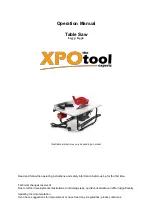
EN
17
SAFETY INSTRUCTIONS
REGARDING THE
PROTECTION BOTTOM
Check lower guard closed properly
before each use. Do not operate
your machine if lower guard does
not move freely or closes instantly.
Never push or tie the lower guard,
if it is open. If saw is accidentally
dropped, lower guard may be
spoiled. Raise the lower guard with
lever blade protector and make sure
it moves freely and does not touch
the blade or any other part, the
angles or depth of cut.
Check the operation of the lower
guard spring. If the guard and the
spring are not operating properly,
should be revised / repaired before
use. Lower guard may operate
slowly if stalled by damaged parts,
gummy deposits, or a buildup
of dirt.
The lower guard must be
removed manually only for special
cuts such as “plunge cut” and
“cortecomposto”. Lower the
bottom guard using the lever blade
protector. As soon as the blade
enters the material, lower guard
must be released. For all other
cutting operations, the protection
should operate automatically.
Always observe that the lower
guard covering the blade before
placing saw a stand or on the floor.
A blade running unprotected cause
the decline of the mountain, cutting
whatever they find in their path.
Pay attention to the time it takes
for the blade to stop after release
the trigger.
WARNINGS
Before connecting the machine to
a power source, make sure that the
voltage source is the same as that
specified on the nameplate of the
tool. A voltage source with a voltage
higher than specified may result
in damage to whoever is using, so
with damage to the machine itself.
If in doubt, do not connect the
machine. Using a voltage source
with a voltage lower than indicated
is detrimental to the engine.
The machine is doubly protected
against any possible electrical
failure. Always remove the plug from
the mains socket before making any
adjustments, maintenance or blade
change.
When operating the machine, use
safety equipment including safety
glasses or protective shield, ear
protection, dust mask and protective
clothing including safety gloves.
Do not use this machine for cutting
firewood. Ensure that lighting is
adequate. Keep the area free
of potential hazards.
Do not let anybody under 18 years
operate this machine.
When operating this machine,
always keep in a lateral position.
Never use a blade snapped
or twisted.
Use only blades properly
sharpened. When cutting round
wood, use clamps pressure so that
the piece does not roll.
Never remove sawdust or scraps of
material, which are along the blade
with his hands. Never use HSS
blades (blades high speed steel).
Clothes, strings, pieces of fabric
and cord itself the machine should
never be left with the desktop.
Avoid cutting nails. Inspect
the workpiece and remove all nails
and other protruding objects before
starting your work. Support the
piece properly. Never lean over the
blade to remove the waste cuts.
Do not attempt to free a jammed
blade without first turning off the
machine. Does not slow down or
stop the blade with a piece of wood.
Let the blade stop naturally.
If you are interrupted while
operating the machine, finish your
work and shut down the machine
before turning his gaze or lose
attention at work.
Verify periodically that all nuts, bolts
and other fasteners are tight.
Do not store materials or equipment
on the machine. Always clamp the
pieces in isolated areas.
If you accidentally cut the wire
or cable itself hidden machine,
the metal parts of your machine
becomes electrically conductive.
Never cut with gas or liquid fuels.
Note the direction of rotation of the
motor and blade.
Do not hold your mobile guard in
“open” position and always make
sure it works properly, spins freely
and go back to cover the teeth
of the blade completely.
Do not use any abrasive wheel
unless the machine has been built
for this purpose. The machine must
be used only for the purpose for
which it was produced. Any other
use than the above herein will be
considered illegitimate use.
The user and not the manufacturer
be liable for any damages resulting
from uses not appropriate.
The manufacturer is not responsible
for any changes that you make in
the tool or for any damage that may
be caused by these changes.
Even when the tool is used
as prescribed, it is not possible
to eliminate all risk factors.
The following issues / hazards may
arise in relation to the construction
of the tool and its design:
1. Contact with the blade.
2. Kickback workpiece.
3. Break the blade.
4. Catapult parts of the blade.
5. Hearing damage if not used
earpiece.
6. Hazardous emissions sawdust
when the machine is used indoors.
Use additional dust extractors
Summary of Contents for PRO-POWER 9711675
Page 27: ......












































